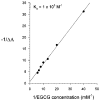Effects of tea and chlorophyllin on the mutagenicity of N-hydroxy-IQ: studies of enzyme inhibition, molecular complex formation, and degradation/scavenging of the active metabolites
- PMID: 9435888
- PMCID: PMC2266694
- DOI: 10.1002/(sici)1098-2280(1997)30:4<468::aid-em12>3.0.co;2-b
Effects of tea and chlorophyllin on the mutagenicity of N-hydroxy-IQ: studies of enzyme inhibition, molecular complex formation, and degradation/scavenging of the active metabolites
Abstract
Green tea and black tea inhibit the formation of carcinogen-DNA adducts and colonic aberrant crypts in rats given 2-amino-3-methylimidazo[4, 5-f]quinoline (IQ), a mutagen from cooked meat. The Salmonella mutagenicity assay was used in the present study to test individual constituents of tea as inhibitors of 2-hydroxyamino-3-methylimidazo[4, 5-f]quinoline (N-hydroxy-IQ), a direct-acting metabolite of IQ. Testing of pure compounds at doses relevant to their levels in tea identified epigallocatechin (EGC) and epigalocatechin-3-gallate (EGCG) as the primary antimutagens. Studies of the inhibitory mechanisms established that the rate of degradation of N-hydroxy-IQ under aqueous conditions was not increased significantly in the presence of tea, in contrast to the results obtained with the complexing agent chlorophyllin (CHL), which rapidly degraded the mutagen. Interaction between N-hydroxy-IQ and several tea constituents was detected in spectrophotometric studies, but the binding constants were only on the order of 1 x 10(3) M-1, suggesting that mechanisms other than complex formation might prevail under the conditions of the Salmonella assay. Comparison of the results in two different strains of Salmonella typhimurium, TA98 and TA98/1,8-DNP6, indicated that the antimutagenic activity of EGCG was dependent, at least in part, on a functional O-acetyltransferase activity in the bacteria. These studies suggest that tea constituents inhibit the enzyme(s) which generate the aryl nitrenium ion and directly scavenge the reactive electrophile, whereas CHL complexes with heterocyclic amines and facilitates the degradation of active metabolites.
Figures






References
-
- Arimoto S, Hayatsu H. Role of hemin in the inhibition of mutagenic activity of 3-amino-1-methyl-5H-pyrido[4,3-b]indole (Trp- P-2) and other aminoazaarenes. Mutat Res. 1989;213:217–226. - PubMed
-
- Arimoto S, Kanyama K, Rai H, Hayatsu H. Inhibitory effect of hemin, chlorophyllin and related pyrrole pigments on the mutagenicity of benzo[a]pyrene and its metabolites. Mutat Res. 1995;345:127–135. - PubMed
-
- Breinholt V, Hendricks J, Pereira C, Arbogast D, Bailey G. Dietary chlorophyllin is a potent inhibitor of aflatoxin B1 hepatocarcinogenesis in rainbow trout. Cancer Res. 1995;55:57–62. - PubMed
-
- Bu-Abbas A, Clifford MN, Walker R, Ioannides C. Marked antimutagenic potential of aqueous green tea extracts: Mechanism of action. Mutagenesis. 1994;9:325–331. - PubMed
-
- Bu-Abbas A, Clifford MN, Ioannides C, Walker R. Stimulation of rat hepatic UDP-glucuronosyl transferase activity following treatment with green tea. Food Chem Toxic. 1995;33:27–30. - PubMed
Publication types
MeSH terms
Substances
Grants and funding
LinkOut - more resources
Full Text Sources

